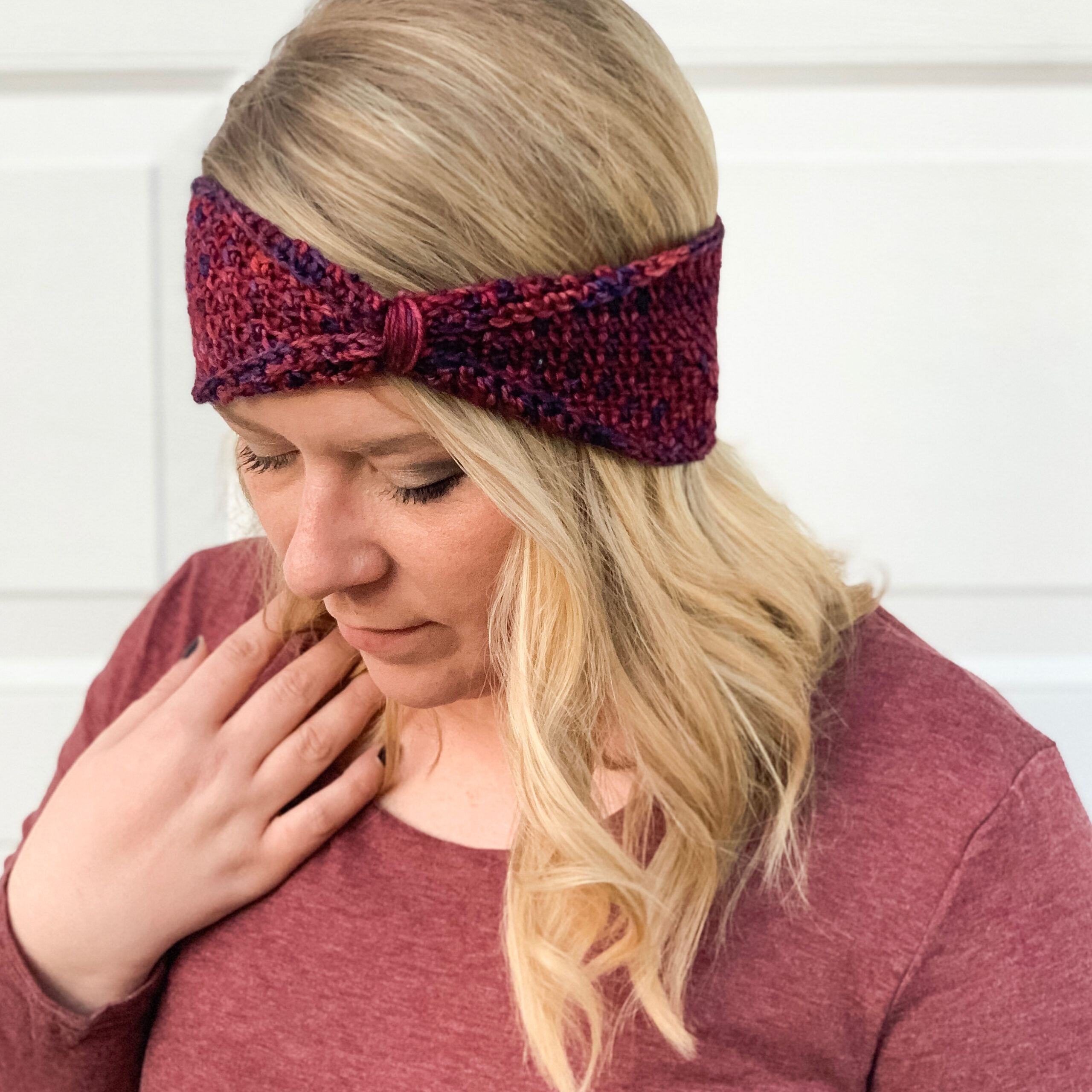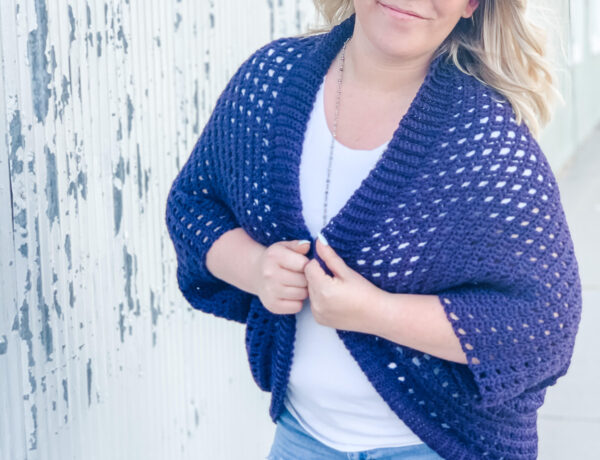Has spring arrived where you live? Here in Kansas we had what I like to call “fake spring” a few weeks ago. Then the temperatures dropped again and we even got snow! Luckily the forecast is showing some warmer temps next week, even reaching into the 80s. I think I’ll finally be able to put away my winter coat. I love making spring items, and this Tunisian crochet triangle scarf is no exception. It’s light and airy – perfect for layering on a sunny day. I think you could easily dress it up by pairing it with a skirt or go casual with some denim shorts.
It’s no secret how much I love Tunisian crochet. I first learned it about two years ago, but in this last year I’ve really got into a groove with it. I love how it sort of mimics the look of knitting, but with a hook! That was my inspo for the Darling Dahlia Shawl – I wanted to create a Tunisian crochet triangle scarf that had some easy colorwork and lace, like so many knit shawls do.
The Yarn
For this design, I used Hawthorne Kettle Dyed and Hawthorne Speckle Hand Painted from WeCrochet. I love this fingering weight yarn – the bright speckles really pop and pair well with the kettle dyed, which has a tonal look to it. Each hank is 357 yards; you’ll need two hanks for your main color, and one for your contrast. I chose to use the Peach Melba Speckle Hand Painted for my main color because the speckles really pop with the tks. For the lace sections, I used the Kettle Dyed in Daphne. There are so many great color options with both of these yarns, you’re sure to find a combo you love.
The Hooks
For all of my Tunisian crochet projects, I use the Radiant Wood Hook Interchangeable Set from WeCrochet. It has all the hook sizes and cord lengths a girl could want – and at an incredible price! I used the longest cord for this Tunisian crochet scarf and it worked perfectly.
Pattern
You can find the entire free Darling Dahlia Shawl pattern below, but if you’d like to purchase an ad free PDF, it is available in my shops.
I’d love to see and share your work! Tag me on social media @hookedhazel or share photos of your WIPs with the hashtag #darlingdahliashawl

Supplies Needed
- WeCrochet Hawthorne Speckle Hand Painted, 80% Fine Superwash Highland Wool, 20% Polyamide (Nylon), Fingering weight, 357 yards/ball, 2 balls
- WeCrochet Hawthorne Fingering Kettle Dye, 80% Fine Superwash Highland Wool, 20% Polyamide (Nylon), Fingering weight, 357 yard/ball, 1 ball
- US I/5.5 mm Tunisian crochet hook with 40″ cord (or size needed to meet gauge)
- Locking stitch marker
- Scissors
- Darning Needle
- Blocking mats & pins
Abbreviations
ch – chain
slst – slip stitch
FwdP – forward pass
RetP – return pass
tks – tunisian knit stitch
tps – tunisian purl stitch
YO – yarn over
2tog – work 2 sts together
inc – increase
mc – main color
cc – contrast color
es – end stitch
Notes
- Pattern is worked top down, from the center out.
- Change colors on the last stitch of the RetP by yo and pull through with new color.
- Work a RetP after each row as follows: ch 1, YO and draw through 2 loops on hook until there is only one loop on the hook.
- Move your stitch marker each row to identify the center stitch.
- Shawl will be aggressively wet blocked to achieve an open and drapey fabric.
- Each row after set up row adds 4 sts.
Special Stitch
Increase – insert hook between last st worked and next st, yo and draw up a loop. Work as a regular st on next row.
Gauge
8 tks x 10 rows = 2″ blocked
Set up Section:
With MC:
Ch 5.
Row 1: Pull up a loop in the 2nd ch from hook and each ch across. <5 sts>
Row 2: *Tks 1, inc 1* repeat from * to * once more, tks 1, es. <7 sts>
Row 3: *Tks 1, inc 1* repeat from * to * three times more, tks 1, es. <11 sts>
Row 4: Tks 1, inc 1, tks 3, inc 1, tks (mark this st as center st), inc 1, tks 3, inc 1, tks, es. <15 sts>
Row 5: Tks 1, inc 1, tks to marked st, inc 1, tks marked st, inc 1, tks until 2 remain, inc 1, tks, es. <19 sts>
Rows 6 – 10: Repeat row 5. <39 sts>
Lace Section:
With CC:
Row 11: Tks 1, inc 1, tps to marked st, inc 1, tks marked st, inc 1, tps until 2 remain, inc 1, tks, es. <43 sts>
Row 12: Tks 1, inc 1, tks to marked st, inc 1, tks marked st, inc 1, tks until 2 remain, inc 1, tks, es. <47 sts>
Row 13: Tks 1, inc 1, *tks2tog, YO*, repeat from * to * until one st before marked st, tks 1, inc 1, tks marked st, inc 1, tks 1, *YO, tks2tog*, repeat from * to * until 2 sts remain, inc 1, tks, es. <51 sts>
Row 14: Tks 1, inc 1, tks to marked st, inc 1, tks marked st, inc 1, tks until 2 remain, inc 1, tks, es. <55 sts>
Row 15: Tks 1, inc 1, tks to marked st, inc 1, tks marked st, inc 1, tks until 2 remain, inc 1, tks, es. <59 sts>
Solid Section:
With MC:
Row 16: Tks 1, inc 1, tps to marked st, inc 1, tks marked st, inc 1, tps until 2 remain, inc 1, tks, es. <63 sts>
Row 17: Tks 1, inc 1, tks to marked st, inc 1, tks marked st, inc 1, tks until 2 remain, inc 1, tks, es. <67 sts>
Rows 18 – 25: Repeat row 17. <99 sts>
Repeat the Lace and Solid sections 4 more times (ending on row 85). Refer to printable chart on next page for stitch counts of each row.
Row 86: Slst bind off. Fasten off.
Finishing:
Soak your shawl for wet blocking. Squeeze/roll out excess water. Using a blocking mat and pins, block your shawl to 64″ wide and 30″ long. Take care to make sure the stripes are crisp and straight. Allow to dry completely before removing from blocking mat. Weave in all ends.




